Ocean Observatories Initiative
The Ocean Observatories Initiative (OOI) is a National Science Foundation (NSF) Division of Ocean Sciences program that focuses the science, technology, education and outreach of an emerging network of science driven ocean observing systems. It is a networked infrastructure of science-driven sensor systems to measure the physical, chemical, geological and biological variables in the ocean and seafloor as well as the overlying atmosphere, providing an integrated system collecting data on coastal, regional and global scales.
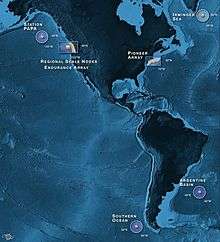
Funded by the National Science Foundation (NSF), OOI builds on the heritage of the ship-based expeditions of the last century and the more recent emphasis to increase ocean observation and in situ monitoring.
OOI's goal is to deliver data and data products for a 25-year-plus time period within a scalable architecture that can meet emerging technical advances in ocean science. These data are freely accessible online through the OOI cyberinfrastructure.
History
In the late 1980s, oceanographers began discussions about coordinating the science, design concepts, and engineering of ocean research observatories, leading to the formation of the International Ocean Network (ION) in 1993.[1] The first nationwide committee was convened in 1995, and was later expanded into the Dynamics of Earth and Ocean Systems (DEOS) program, which laid the groundwork for an ocean observatory network.[2] In 2003 the Pew Oceans Commission recommended changes designed to improve society's use and stewardship of, and impact on, the coastal and global ocean.[3][4]
Two National Research Council (NRC) studies in 2000 and 2003 (“Illuminating the Hidden Planet: The Future of Seafloor Observatory Science”[5] and “Enabling Ocean Research in the 21st Century”[6] ), and a series of workshops increased the push for research-oriented ocean observing. The National Science Board (NSB) approved the OOI for inclusion in a future National Science Foundation budget in 2000, which allowed for focused planning efforts.
In 2004, the NSF Division of Ocean Sciences established the OOI Project Office to facilitate further OOI planning between two independent groups, Joint Oceanographic Institutions and Consortium for Ocean Research and Education.[7] In the following year, the OOI Project Office asked for the ocean research community’s help in developing the OOI network design, resulting in 48 proposals from over 130 separate educational and research institutions. These proposals helped to inform the initial Conceptual Network Design (CND) for the OOI, which then served as the focus at a OOI Design and Implementation Workshop in March 2006.
In 2007, the National Science and Technology Council's Joint Subcommittee on Ocean Science and Technology[8] developed an Ocean Research Priorities Strategy,[9] which provides a research investment framework to advance understanding of ocean processes and interactions that facilitate responsible use of the ocean environment. The ORPS identified three cross-cutting elements, one of which is ocean observing for research and management.
In late 2007 the OOI project underwent its Preliminary Design Review[10] and in 2008 completed its Final Network Design Review resulting in the Final Network Design.[11] In May 2009, the National Science Board authorized the Director of NSF to award funds for the construction and initial operation of the OOI. In September 2009, NSF and the Consortium for Ocean Leadership signed the Cooperative Agreement[12] that initiated the construction phase of the OOI.
Locations of OOI's global arrays, selected by a team of about 300 scientists,[13] targeted areas that were under-sampled and subject to rough conditions that were challenging for ship-based measurements. As originally planned, the global study sites included installations in four locations: Irminger Sea, Southern Ocean, Argentine Basin, and Station Papa.
After nearly 10 years and expenses of US$386 million, in June 2016, NSF announced that most OOI data were flowing in real time from more than 900 sensors at the 7 sites. The annual budget is approximately $55 million.[14]
In October 2018, the management office of the OOI moved from the Consortium for Ocean Leadership to the Woods Hole Oceanographic Institution. In 2017, the Argentine Basin Array was terminated and the Southern Ocean Array was reduced in scope, and later removed.[15]
Organizational structure
The OOI Program is managed and coordinated by the OOI Project Office at the Woods Hole Oceanographic Institution[16] (WHOI), with four organizations responsible for operations and maintenance of specific components of the OOI system.
- Woods Hole Oceanographic Institution[17] responsible for the Coastal & Global Scale Nodes, which includes the Coastal Pioneer Array and two Global Arrays, including their associated moorings, autonomous vehicles, and sensors.
- Oregon State University[18] is responsible for the Coastal Endurance Array moorings, autonomous vehicles, and sensors.
- University of Washington is responsible for the Regional Cabled Array, including its cabled seafloor systems, moorings, and sensors.
- Rutgers, The State University of New Jersey is managing the OOI’s Cyberinfrastructure.
Themes
The sites and platforms of the OOI components target the following key scientific processes:
Ocean-atmosphere exchange
Quantify the air-sea exchange of energy and mass, especially during high winds (greater than 20 meters-per-second), to provide estimates of energy and gas exchange between the surface and deep ocean. Such measurements should improve the predictive capability of storm forecasting and climate change models.
Climate variability, ocean circulation and ecosystems
Examine how climate variability affects ocean circulation, weather patterns, the ocean's biochemical environment and marine ecosystems.
Turbulent mixing and biophysical interactions
Understand the role of turbulent mixing in the transfer of materials within the ocean and in the exchange of energy and gases between the ocean and atmosphere.
Coastal ocean dynamics and ecosystems
Quantify the processes governing the coastal ocean.
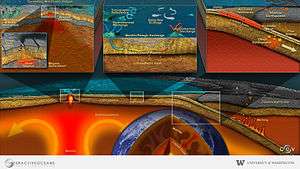
Plate-scale, ocean geodynamics
Examine the degree to which active tectonic plate boundaries influence the ocean from physical, chemical and biological perspectives. Lithospheric movements and interactions at plate boundaries at or beneath the seafloor are responsible for short-term events such as earthquakes, tsunamis and volcanic eruptions. These regions are also host to the densest hydrothermal and biological activity in the ocean basins.
Fluid-rock interactions and the subseafloor biosphere
The oceanic crust contains the largest aquifer on Earth and supports a vast deep biosphere. Thermal circulation and reactivity of seawater-derived fluids can modify the composition of oceanic plates, lead to the formation of hydrothermal vents that support unique micro- and macro-biological communities and concentrate methane to form massive methane gas and methane hydrate reservoirs.
Components
The four main components that comprise the OOI are: Coastal Global Scale Nodes (CGSN); Regional Scale Nodes (RSN); Cyberinfrastructure (CI) and Education and Public Engagement (EPE). Implementing organizations are responsible for these components.
Coastal Global Scale Nodes (CGSN)
The CGSN is made up of two coastal arrays and four global arrays.
Coastal arrays provide sustained, adaptable access to complex coastal systems. Coastal arrays extend from the continental shelf to the continental slope, allowing scientists to examine coastal processes including upwelling, hypoxia, shelf break fronts, and the role of filaments and eddies in cross-shelf exchange. Technologies that gather data in the coastal region include moored buoys with fixed sensors, moored vertical profilers, seafloor cables, gliders and autonomous underwater vehicles.
The coastal observatory includes a long-term Endurance Array in the Eastern Pacific and a re-locatable Pioneer Array in the Western Atlantic. Woods Hole Oceanographic Institution installed and operates the Pioneer Array. Oregon State University installed and operates the Endurance Array.
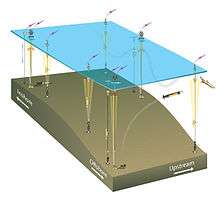
Pioneer Array
The Pioneer Array is a network of platforms and sensors that operate on the continental shelf and slope south of New England. A moored array is centered at the shelf break in the mid-Atlantic Bight south of Cape Cod, Massachusetts. Autonomous underwater vehicles (AUVs) sample the frontal region in the vicinity of the moored array and gliders resolve mesoscale features on the outer shelf and the slope sea between the shelf break front and the Gulf Stream.
The Pioneer Array provides a three-dimensional view of key biophysical interactions at the shelf break using its flexible, multiplatform array that combines moored and mobile components with high spatial and temporal resolution. In its initial location south of Cape Cod, the Pioneer is embedded within an established regional observing system. The Pioneer Array is planned to move from place to place over approximately five-year intervals to characterize processes in different coastal ocean environments.[19]
Endurance Array
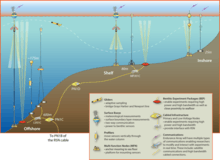
The Endurance Array, located on the continental shelf and slope off Oregon and Washington, provides a long-term network of moorings, benthic nodes, cabled and uncabled sensors and gliders. The array consists of two lines of moorings, one off Newport, Oregon (the Oregon Line) and the other off Grays Harbor, Washington (the Washington Line). Gliders sample between the mooring lines. The array focuses on observing the influence of the Columbia River on the coastal ecosystem. It also samples a prototypical upwelling regime on a narrow continental shelf where anoxia events are common. Some Endurance Array Oregon Line infrastructure connects to the RSN cabled network to provide enhanced power and communications for observing water column and seafloor processes.[20]
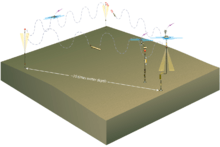
Global Arrays
Locations of the global arrays were selected by a team of scientists (~300 people)[21] based on regions that are under-sampled and subject to extreme conditions (e.g., high winds and sea states) that are challenging for continuous or even frequent ship-based measurements. The planned global study sites include instrumented moorings and gliders in four locations: Argentine Basin;[22] Irminger Sea;[23] Southern Ocean;[24] and Station Papa.[25] The global arrays are developed and operated by Woods Hole and Scripps.
Observations from these high latitude areas are critical to understanding ocean circulation and climate change processes. The global arrays each include four moorings (except Station Papa, which has three) composed of fixed and moving sensors that measure air-sea fluxes of heat, moisture, and momentum—as well as physical, biological, and chemical properties of the water column. Each array also includes gliders to sample within the array's footprint.
Regional Scale Nodes (RSN)
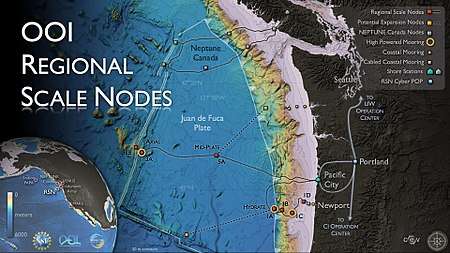
Regional Scale Nodes are cabled arrays of ocean observing sensors in the Northeast Pacific Ocean. They are connected by approximately 900 kilometers (560 miles) of electro-optical cable. The design provides high power (10 kV, 8 kW) and bandwidth (10 GbE) to sensor arrays on the seafloor and throughout the water column using moorings with instrumented wire-following profilers, 200 m instrumented platforms and winched profilers. The RSN was installed and operated by the University of Washington.
The two primary study sites are Hydrate Ridge, an area of massive sub-seafloor gas-hydrate deposits and fluxes of methane from the seafloor into the ocean, and Axial Seamount, the most magmatically robust volcano on the Juan de Fuca Ridge spreading center that erupted in April 2011.
The RSN complements the NEPTUNE cabled observatory that Ocean Networks Canada operates on the northern Juan de Fuca plate. Together these observatories enable long-term, plate-scale seafloor and ocean investigations in the Northeast Pacific.[26]
Cyberinfrastructure

The Cyberinfrastructure component links marine infrastructure to scientists and users. It manages and integrates data from the different OOI sensors. It provides a common operating infrastructure, the Integrated Observatory Network (ION), connecting and coordinating the operations of the marine components (global, regional, and coastal scale arrays). It also provides resource management, observatory mission command and control, product production, data management and distribution (including strong data provenance) and centrally available collaboration tools.
ION connects and coordinates operations of the OOI marine components with oceanographic research communities. The University of California, San Diego initially designed the cyber infrastructure. The project later relocated to Rutgers University.[27]
Education and Public Engagement (EPE)
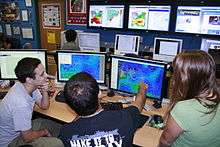
Education and Public Engagement includes educational data visualization tools to engage students in active scientific inquiry. Collectively, these tools provide easy access for the development and use of scientific data visualization, helping translate science themes into educational materials, deliver the capability to build and edit online lesson and lab units, enable virtual collaboration and sharing of oceanographic data and learning materials and facilitate broader data access. Services were developed and integrated into a single interface planned for release in fall 2014—accessible through a web application programming interface (API). This API also provides a framework that other computer scientists and programmers can use to develop new educational products for the web and other mobile applications.
Specifically, the EPE planned five online services including:
- Educational visualization tools
- Ontology-linked concept mapping tool
- Lab-lesson builder
- Educational resource database
- Collaboration portal for educators.

References
- Delaney, J.R (1987). Scientific Rationale for Establishing Long-Term Ocean Bottom Observatory/Laboratory Systems. Springer, Dordrecht.
- Orcutt, J.A; Berger, J; Vernon, F.L. "Stable platform designs for global DEOS moorings". astrophysics data system. American Geophysical Union.
- "Pew Oceans Commission. May 2003. America's Living Oceans: Charting a Course for Sea Change" (PDF). Archived from the original (PDF) on 2012-02-07.
- "Our work". Archived from the original on April 7, 2014. Retrieved 2016-06-07.
- National Research Council. "Illuminating the Hidden Planet: The Future of Seafloor Observatory Science". National Academy of Sciences. The National Academies Press.
- National Research Council. "Enabling Ocean Research in the 21st Century: Implementation of a Network of Ocean Observatories". National Academy of Sciences. The National Academies Press.
- Schofield, Oscar; Tivey, Margaret K. (June 2004). "Building a Window to the Sea: Ocean Research Interactive Observatory Networks (ORION)". Oceanography.
- "Subcommittee on Ocean Science and Technology".
- "National Science and Technology Council's Joint Subcommittee on Ocean Science and Technology. 2006. Charting the Course for Ocean Science for the United States for the Next Decade: An Ocean Research Priorities Strategy (ORPP)" (PDF).
- "Preliminary Design Review". 14 June 2010.
- Ocean Observatories Initiative. 2010 Final Network Design
- "Ocean Leadership: Cooperative agreement".
- Daly, Kendra; Jahnke, Richard; Moline, Mark; Detrick, Robert; Luther, Doug; Matsumoto, George; Mayer, Larry; Raybould, Keith. ". Design and Implementation Workshop Report" (PDF). Ocean Leadership.
- Witze, Alexandra (2016-06-09). "US ocean-observing project launches at last". Nature. 534 (7606): 159–160. Bibcode:2016Natur.534..159W. doi:10.1038/534159a. PMID 27279186.
- Sea Change: 2015–2025 Decadal Survey of Ocean Sciences (Summary). National Academies Press. 2015. p. 11.
- "Ocean Leadership: Policy & Legislation".
- "Woods Hole Oceanographic Institution".
- "OSU major participant in initiative to create global ocean observatory system". Oregon State University. 9/2/2009. Check date values in:
|date=(help) - "Pioneer Array At-Sea Test of Buoys Now Scheduled for September". 28 March 2011.
- "Coastal Endurance Array Online Instrument Tables". 29 September 2015.
- Daly, K., R. Jahnke, M. Moline, R. Detrick, D. Luther, G. Matsumoto, L. Mayer, K. Raybould. May 2006. Design and Implementation Workshop Report
- "Argentine Basin".
- "Irminger Sea".
- "Southern ocean". Archived from the original on 2012-05-08. Retrieved 2013-03-02.
- Station Papa
- "OOI Station map Regional Scale Nodes". Archived from the original on 2012-05-02. Retrieved 2013-03-02.
- Witze, Alexandra (27 November 2014). "Ocean observatory project hits rough water". Nature. 515 (7528): 474–475. Bibcode:2014Natur.515..474W. doi:10.1038/515474a. PMID 25428476.